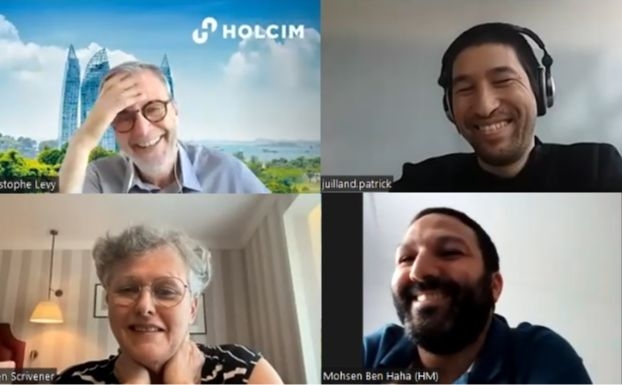News

Interview with the authors of the regional (Europe) paper in RILEM Tech Lett
RILEM Technical Letters has recently published its 4th regional paper, titled “Research needs for cementitious building materials with focus on Europe”. This interview is with the 4 authors of this paper: Karen Scrivener - Laboratory of Construction Materials, EPFL, Lausanne, Switzerland, Mohsen Ben Haha - HeidelbergCement Technology Centre, Leimen, Germany, Patrick Juilland - Sika Technology, Zurich, Switzerland, and Christophe Levy - Holcim innovation Centre, Saint Quentin Fallavier, France.
25 May 2023
***
Daniela Ciancio – RILEM Implementation Manager (RIM): Thank you for joining me today! I usually interview the first author of the regional papers published in RILEM Tech Lett, but in this occasion, I have the pleasure to interview all the 4 authors. Shall we start from the beginning? How and when did everything happen? Did Karen lead the situation?
Christophe Levy (CL): Not at all (everybody laugh!)
Monhsen Ben Haha (MBH): Karen, you can give the whole story starting from the last meeting in Zurich when we were in the NanoCem meeting.
Karen Scrivener (KS): Yes! Basically Alexandra (Editor’s note: Alexandra Bertron, Editor in Chief of RILEM Tech Lett) asked me to write this paper a long time ago… too long time ago. She said “well, maybe you can involve some people from the industry”. That's when I reached out to these three here. I should perhaps confess that Mohsen and Patrick were my former Ph.D. students a long while ago now; and then for Christophe, also I have known him for a long time. So, I think we have here represented the two biggest cement producers based in Europe and one of the biggest admixture companies. So, you know…, it was really pulling on what's going on in the industry.
RIM: So… it was not hard to convince the other three authors to join in and to write the paper.
KS: Not at all, but then it was a very protracted process. Well, we're one or two years late in delivery, I think we were two years late in delivering, yeah.
CL: Two years!
MBH: But we enjoyed the time of COVID at least because so we had a reason to meet and stay connected.
CL: To answer your question, Daniela, at least for me, but I'm sure for my 2 colleagues too: it has been a pleasure to work with Karen on such complex and fundamental paper, and useful… hopefully useful! When I have been asked, I didn’t hesitate to say yes. I was very, very excited about that. It's true that it has taken a little bit longer than expected, but it has been fascinating.
RIM: I didn't know that it took that long. It was a really long journey. I understand everything happened online, or you met each other in person sometimes?
KS: No, I think we did it all online.
RIM: The paper is 33 pages long.
KS: Yeah, it's very long paper.
MBH: … and with our English style, Karen had a lot to correct! (everybody laugh!)
RIM: The most important message that I can grab from the paper is that we are running out of time to reach the ambitious goal to be carbon neutral by 2050. Is it in this spirit/frame-of-mind that you encourage “University researchers to spend their energy and resources to solve these major issues rather than some other trendy subjects having hardly a chance to be industrially and commercially developed.”? Do you really think that funding of "side roads research topics" have to be abandoned?
KS: We live in a free country, we can't determine what happens, but that's what I really think.
MBH: I think there are some fundamental research programs trying to solve some of the questions that we highlighted in our paper. Such programs should be absolutely funded and given a chance. But there is also a huge amount of money which is invested into things that will never be applied and then will never solve the issue of the CO2 emissions we are facing now.
CL: First, we wanted to have a useful paper in order to help some universities to decide where to invest money, government money, on what we consider priority topics. It has been, at least for me, very difficult, not because we disagreed - most of the times, we all agreed on what are the priorities, we were really aligned on 99.9% of the subjects- but because I asked myself “who am I to tell universities they are working on a non-priority subject? Who am I to tell a Professor who has been working for one decade, or even 2 decades, on a certain topic that he/she is wasting his time and the time of his/her government?” It was a very difficult compromise between our convictions and being polite. For me it was really difficult to find the correct balance; but we tried to find the right level in order to be sure that we are helping and supporting the universities to use less money on non-priority subjects.
RIM: Do you think that if we had had more time, if we had had more resources then… yes! Any research topic is welcome; but at this stage, the situation is dictated by this emergency?
ALL Authors: Yes! Without any doubt!
MBH: Some of the topics that we encourage to abandon started already in the 70s; there is no market for them. So… the question is “should we invest even more time just because the idea looks sexy and fancy, and people like to hear about it?” or “should we focus on projects that can bring us some real added value, the results of which we can implement immediately to solve our problems?”.
Patrick Juilland (PJ): If I may add… With any research you pursue long-term goals. Additionally, implementation needs time too. When a topic has been on the agenda for a long period of time, and research results haven’t led to any projects or implementations, then those topics probably don’t appear to be right ones to pursue.
CL: I'd like to add that, as I was speaking just before about respect, we need to respect taxpayers. Many projects are using our taxes and I think, as a taxpayer, I'd like to know that the universities are working on useful matter who will help to solve the climate issue.
KS: … and I think we have a problem of funding agencies which don't usually have experts on cement and concrete with them. And frequently they're convinced by rather farfetched ideas because they are presented in a friendly way which hold out the hope of producing big changes.
CL: That applies for the universities; in addition, we've got exactly the same issue with the startups that are funded by venture capital funds, for instance, which do not know much about the real problem but the if they hear “we're going to solve the climate issue and save the planet”, they will give millions and millions!
RIM: I see. You were talking about university research financed by public funds. But what about the research carried out in the laboratories of the companies you work for? In other words, you stress in the paper that the statements reflect the opinion of the authors. Would you say that they also represent the point of view of the industry you work for (Holcim, Sika and HeidelbergCement)? Will this strategic vision of the challenges of research and development be implemented within your respective companies, and how?
CL: I consider myself as a voice of my team, as a voice of HOLCIM. I still believe it was a good decision to say “no” to certain topics without priority. So yes, I think it's not only my personal point of view. I'm very comfortable with saying that it serves my company.
KS: I think one thing people don't realise is that most of these topics we call “crazy” have been worked on in these industrial laboratories. It's not that they're saying they're crazy just based on other people's research. They've usually worked on them themselves, often for extremely long periods of time; and this has led them to confirm what we're saying, but this is not in the public domain because it's often been kept secret. They don't like to admit that they wasted 10 years of work on a particular topic.
MBH: We worked on most of these ideas, but then you should give up at a certain moment when you see that there is no solution for it. Regarding your question, the research topics that we have identified in the paper are not that far from what HeidelbergCement is focusing on now. There are additional ones for sure, like for example carbon capture, which is a topic we have not covered a lot in the paper as it is not really a university topic. Finally, what is written on the paper is my proper opinion, but it does not differ too much from HeidelbergCement’s thoughts on cement research.
PJ: With Sika, it's a bit different because we work with different raw materials. In the end, we mainly develop and sell concrete additives. My company supports the Science-Based Target initiative (SBTi) and commits to Net Zero by 2050. At Sika, it's not just about additives, but since that's what my contribution in the paper is about, I'll just refer to that. Sika is also trying to find new, alternative raw materials that basically have a lower environmental impact, but we didn't really talk about that in the paper. We're primarily an enabler of sustainable construction, trying to find ways to develop concrete with a lower carbon footprint with our admixtures and solutions. And that's one of the main trends we're working on.
CL: Just to confirm what when we finally finished the paper, I pass it to one of my colleagues: I had no negative feedback saying “why did you say that? What? You forget this or you shouldn't say that”. So, I feel comfortable with this.
RIM: Now a question for Patrick, Mohsen and Karen. 3 out of 4 of the authors of this paper have been affiliated with EPFL. How much has this connection influenced the views/statements in the paper?
MBH: Did you leave EPFL, Patrick?
PJ: I have the impression that I am still at EPFL, you know? (everybody laugh!) Once you had Karen as your boss, she remains your boss for the rest of your life! (everybody laugh again!)
MBH: More seriously, now. My PhD was done in 2006 at the EPFL and it was on Alkali-silica reaction, a topic we didn't touch at all in the paper. I collaborated as well afterwards with Karen on multicomponent cements from the industry side, and the reason to collaborate with Karen was because she has the right industrial background, as before joining EPFL Karen worked in the industry sector. We, as industrials, come with a question; we have the feeling that she, as a professor, can understand exactly what we mean, and we get the answer that we need. It is clear that EPFL is a good school, we learned a lot from her. But then I have to admit that I worked as well in one of the topics that I criticised in this RILEM Tech Lett paper: my most cited papers are tackling the alkali-activated materials topic! I know how hard it's really to bring such product into the market in a certain way.
KS: I just want to add that even I have a highly cited paper on alkali-activated materials. I don't think most of what we say is a matter of opinion. We've really looked at it in a scientific way and these are the facts of life in the industry. As Mohsen said, it's something it's been worked on since the 70s and you've ended up producing more in the University Labs that what has been applied in the field. This has to tell you it's not going to work.
PJ: I think besides the fact that we say that we should not focus on certain topics, what we highlight in this paper is that there's actually a lot of topics that still need to be tackled. I think that's the important message of the paper. Karen has worked on most of these subjects and we, as her students, have been influenced and educated in these topics.
CL: This is why we made the watermelon figure (Editor’s note: the image on page 247 of the paper), in order to show in one graph where the priorities are. There are so many things to be tackled. Concrete is so complex topic affected by so many different parameters: we needed to identify a priority scheme.
RIM: Who is the target of your paper? I can see that governmental bodies and funding bodies are definitely part of the audience. Who else?
CL: Universities.
KS: The whole research community and also people in the industry.
MBH: I think we also wanted to send a message to new/young researchers. As Christophe mentioned, it's hard to convince people who have worked on certain topics for decades to move away from them. But the new generation, they should really be able to free themselves and to look to really what is needed now; we are hoping to convey this message to young researchers. If they could get their new ideas from this paper, it would be the best thing that we could make from this paper.
CL: It seems to be a success when you look at ResearchGate who is reading this paper, a lot coming from very young researchers. Which is great because it was our objective.
RIM: When I read this paper, I thought it's not far away from being a book (everybody laugh)! But the question is “how quickly such a book would be overrun by new technologies?”.
CL: I can tell you the truth. The first thing I asked was “how many pages”, and I was told “10 to 20”. I worked on the very first draft of table of contents with a lot of details and I remember Karen asking me “do you want to write a book or what?”. And I said “no, no!”, but in fact we finished with a huge number of pages.
MBH: I think few years ago when we still had the NanoCem running, we were running a kind of brainstorming ideas about what is really missing and so on. If I see at that collection of idea, yes, there would be enough to write a book. I think that Christophe has done an extremely good job because we started with hundred questions to end up with a few questions.
PJ: Regarding the second part of your question, I don't think that we would necessarily be overrun by new technologies. Of course, there would be some new implementation that may occur in practice. But I mean, these are some very fundamental questions that still need to be answered.
KS: And that's one of the main messages of the paper to say there are no new miracles out there. We have to realise that we're limited by the availability of resources, above all the composition of the Earth. And this means that things are not going to change completely, but we need use the things we have better and more efficiently rather than kind of living in this cloud, cuckoo land, that suddenly something is going to come along that can do things differently.
RIM: We have come to the end. Thank you for writing this paper, and for finding the time to talk to me today!
ALL AUTHORS: Thank you. Bye-bye.














No comment
Log in to post comment. Log in.